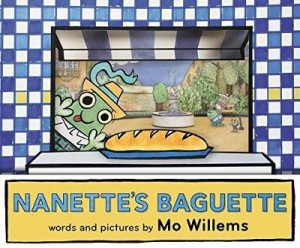 Mo Willems
Mo Willems
(Walker Books)
Today is an important day for Nanette: her mother has entrusted her with the responsibility of buying the family’s daily baguette. This is Nanette’s first solo trip to the bakery and she is elated at the prospect. But temptation of the warm fresh bread is too much to bear and Nanette finds herself going home empty-handed and beset with regret. Will Mum be cross?
Willems’ one of a kind humour and adroit use of language and his ingenious use of mixed media come together to create a tale which will have its readers roaring with laughter. Splendid word play around the word baguette guides the tale, allowing Willems to display shrewd rhyming. It is an absolute joy to read aloud, and one can’t help but feel exhilarated and liberated when reading this wonderfully joyous text. His signature bold colourful artwork helps amplify the exuberance of the tale as does his use of comic-strip like features such as fonts and visual onomatopoeia. This creates a welcome balance with the otherwise rather quaint setting, beautifully crafted thanks to his paper-modeled village.

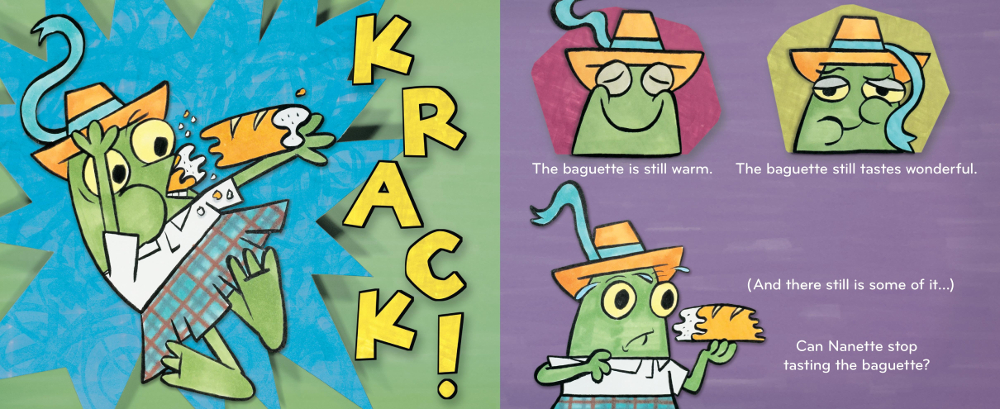
(Zoe of Playing by the book has developed a superb activity which allows you to recreate the village; you can find it in her post on the book here.)
Nanette’s Baguette is a glorious, irresistible story of learning to do things one one’s own and owning up to one’s (very understandable in this case) mistakes. It deeply resonated with me, for many reasons, and made me think of how as adults, we relate to picturebooks.
There has been a lot of research on how picturebooks help children make sense of the world around them, support their emotional development as well their acquisition of language. Much of this is done through joint-attention reading, with a facilitator reading the story and conversing with the child as they read. Not that this necessarily stops once a child can read; the first reaction of my daughter (12) on reading Nanette’s Baguette was “That’s us! We do that!”, delighted to see this rather naughty habit of ours (which has resulted many times in some frowns from other shoppers in the local supermarket) reflected and celebrated so. This is exactly the reaction I was expecting from her.
Reading picturebooks as an adult, however, is a bit like time-travelling. Sometimes, this is because we read and were read those very books in childhood (I have some strong emotional ties to some of Richard Scarry’s stories that way), but sometimes it is because we are vicariously reliving our own childhoods. While many have been left uncomfortable with the use of frog-like characters for a story which oozes Frenchness from every page, I have not; Nanette’s Baguette is such an triumphant celebration of something that is so intricately weaved into my cultural heritage, I simply cannot see any harm to it. But this is not only my cultural heritage, but my family heritage too; I come from a family of bakers on my mother’s side, and Nanette’s Baguette inspired me to delve back into childhood memories of bakeries and baguette-buying.
My grandparents’ bakery
I never knew this bakery, not while my grandparents owned it anyway. They retired and sold it at the end of the 1950s, and my grandmother died many years before I was born. Yet my childhood was full of stories about the bakery: how my mother used to deliver the bread; how they had ‘pudding’ at home, made from all the unsold cakes and viennoiseries; how my grandmother would continue to serve her customers until the advanced stages of labour (she gave birth to 10 children); how after D-Day, American soldiers would hang around in the street because my grandmother could speak English (and they would take my then three-year-old mother on rides on their jeeps, but that’s a story for another post). Everyone in the family worked at the bakery at some point. My grandfather had two sisters and they both married bakers as well. There was just no getting away from bread!


My uncle’s bakery
My mother’s eldest brother (the little boy sitting on the step in the picture above) became a baker himself (and his son after him). They had two bakeries, though I only knew the second of the two. I went there most Sundays after visiting my paternal grandparents. We would go in the back first, in the ‘laboratoire’ where my uncle would feed us the cakes that had could not be sold or squirt crème pâtissière straight into our mouths from the piping bag. Then we would go to the front of the shop, where my aunt would often give us chocolate. It was a tough childhood, I know.

My local bakery
Just like Nanette, I went to get bread on my own once I was old enough; it is truly a rite of passage when you are a child in France. I too used to have a bit of a bite on the way, but my mother was not always quite as understanding as Nanette’s mother. I can’t say it cured me of the habit (see the final picture below!). This is the local bakery I walked to when I first started to get bread by myself:
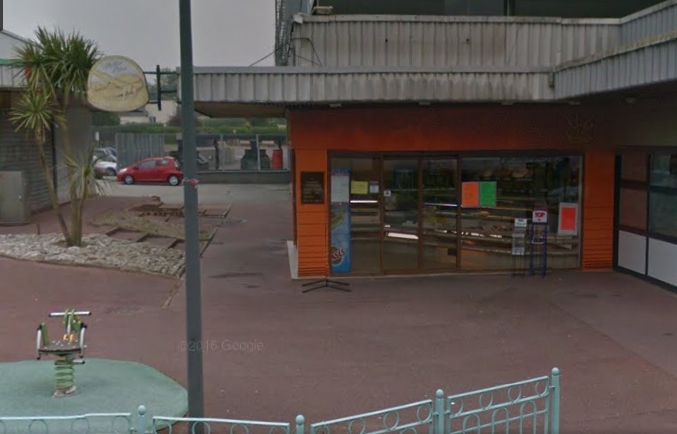
There I bought my first baguettes, my first 10-centime sweets, looked with envy at the chocolate bars and Kinder eggs I was never allowed. As you can see, not all bakeries are quite as quaint as Juliette’s bakery. This is in the middle of the very underprivileged council estate my parents live on the edge of and where I went to school and spent all my childhood. Bread is vital to French way of life, regardless of social background.
My parents still buy their bread there daily; unfortunately when I tried to go to take pictures of it it was closed, so I also went to the bakery they use when in town on market days:
Honest, I have no idea whose fault that was *ahem*:
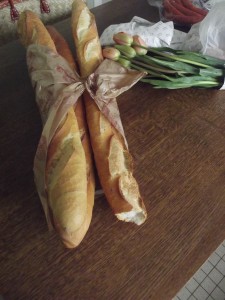
Reading Nanette’s Baguette highlighted to me how picturebooks offer parents and carers a wonderful opportunity to share childhood memories with their children. In a world so focused on materialism, it is worth remembering that the most cherished childhood memories are often made of the simplest things. Thank you Mo Willems for reminding me of that.
—
Nanette’s Baguette is out now. You can buy a copy here.
Many thanks to my aunt Marie-Thérèse and my cousin Christian from providing the photographs.
Source: review copy from publisher


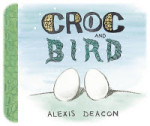


I really enjoyed reading this lovely nostalgic post and love the inclusion of all the photos. Our baguettes often come back from the bakery with an end missing too 😉
So they should, that’s when they taste the best!